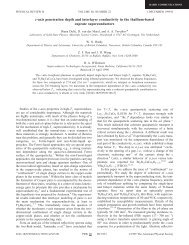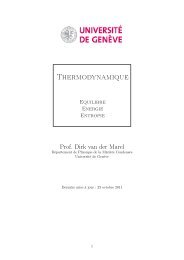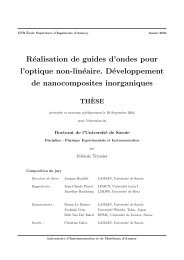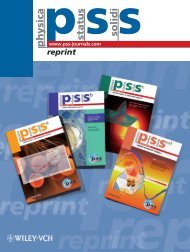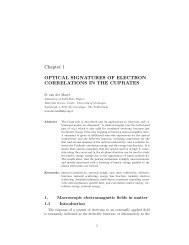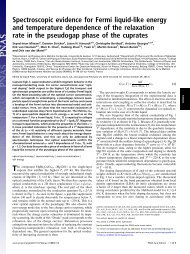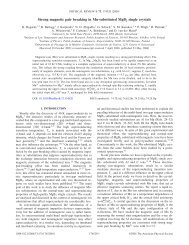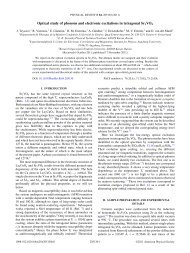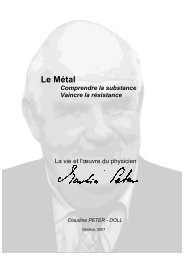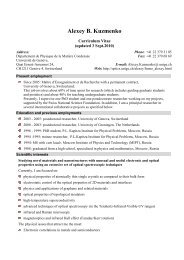software to fit optical spectra - Quantum Materials Group
software to fit optical spectra - Quantum Materials Group
software to fit optical spectra - Quantum Materials Group
Create successful ePaper yourself
Turn your PDF publications into a flip-book with our unique Google optimized e-Paper software.
−1<br />
where ( α ) kl is the inverse Hessian matrix also called the ‘covariance matrix’. Note, that all<br />
−1<br />
2 2 ( 0)<br />
( 0)<br />
the diagonal elements ( α ) kk are positive because χ ( 0)<br />
= χ ( p1 , K,<br />
pM<br />
) is a local minimum<br />
point and Equation 2-14 can always be applied.<br />
The reasonable choice of<br />
defined by the condition:<br />
2 ⎛ M δχ ⎞<br />
P ⎜ , ⎟ = p ,<br />
⎝ 2 2 ⎠<br />
2<br />
2<br />
δχ absolute value is quite an issue. Ideally, δχ should be<br />
Equation 2-15<br />
where M is the number of parameters, p is the desired confidence probability limit (typically,<br />
x<br />
∞<br />
p = 0.<br />
95 ) and ⎜<br />
⎛ −t<br />
a−1<br />
≡ ⎟<br />
⎞<br />
⎜<br />
⎛ −t<br />
a−1<br />
P(<br />
a,<br />
x)<br />
⎟<br />
⎞<br />
⎝∫<br />
e t dt /<br />
0 ⎠ ⎝∫<br />
e t dt is the incomplete gamma-function (the<br />
0 ⎠<br />
derivation can be found in Ref. [3]).<br />
However, the Equation 2-15 can be applied, if (i) the data points are statistically<br />
independent, (ii) all weight coefficients w ν are unities, and (iii) the model is absolutely<br />
adequate <strong>to</strong> the data. However, as was mentioned in the section 2.1.2, the existence of the<br />
systematic error bars invalidates the first two assumptions. One also needs much optimism <strong>to</strong><br />
2<br />
heavily rely on the assumption (iii). In this situation the choice of δχ becomes rather<br />
ambiguous and, therefore, human-dependent.<br />
Fortunately, from Equation 2-14 it follows that<br />
2<br />
δχ scales the confidence limits of all<br />
parameters proportionally. One can therefore reliably compare the error bars of different<br />
parameters, even though their absolute values might be ill-defined.<br />
2.2. Modeling of the dielectric functions<br />
The central assumption in the calculations RefFIT does is that all measurable <strong>optical</strong><br />
quantities (such as reflectivity, penetration depth etc.) can be expressed in terms of the complex<br />
frequency-dependent dielectric function ε ( ω)<br />
= ε1<br />
( ω)<br />
+ iε<br />
2 ( ω)<br />
of the material under study.<br />
Therefore, the most important issue is the modeling of the dielectric function itself.<br />
2.2.1. Physical properties of the dielectric functions<br />
It is well-known from the textbooks (e.g., [2]) that any realistic dielectric function ought<br />
<strong>to</strong> satisfy certain physical conditions.<br />
First of all, ε1 ( ω)<br />
= ε1<br />
( −ω)<br />
and ε 2 ( ω)<br />
= −ε<br />
2 ( −ω)<br />
, therefore it is sufficient <strong>to</strong> model the<br />
ε (ω)<br />
for ω ≥ 0 only.<br />
Secondly, ε 2 ( ω > 0)<br />
≥ 0 , which means that the intensity of light cannot increase in the<br />
direction of propagation.<br />
Guide <strong>to</strong> RefFIT Page 14



